|
|
| |
 |
|
| |
田润德
编译文/图 2020-09-28
20:36 |
|
| |
|
|
|
|
| |
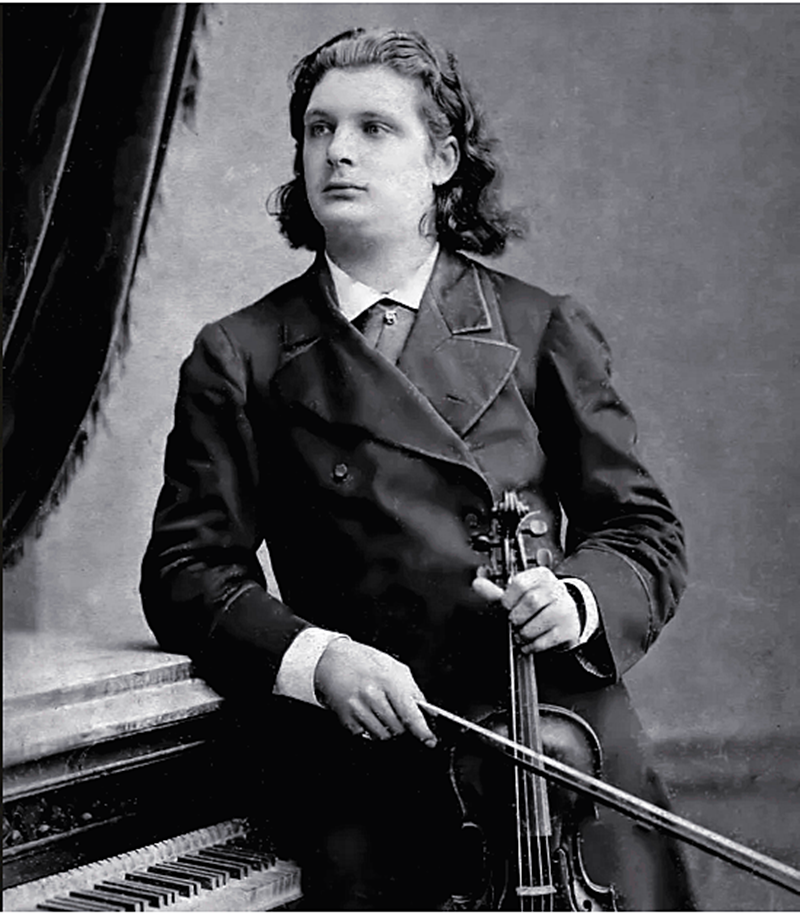 |
|
|
|
| |
尤金·伊萨依(Eugene Ysaye 1858- 1931) |
|
|
|
| |
|
|
| |
塞萨尔·弗兰克(1822 - 1890)
A 大调小提琴与钢琴奏鸣曲,作品编号 FWV 8(1886 年)
小提琴:雅克·蒂博(1880 - 1953)
钢琴:阿尔弗雷德·科尔托(1877 - 1962)
© 2008 爱富龙唱片有限公司。华纳古典唱片公司出品,版权归属 1930 年、1989 年帕罗非姆唱片有限公司。 |
|
|
|
| |
César Franck (1822-1890)
Sonata for Violin and Piano in A Major, FWV 8 (1886)
Violin: Jacques Thibaud (1880-1953)
Piano: Alfred Cortot (1877-1962)
© 2008 EMI Records Ltd. A Warner Classics release, ℗ 1930, 1989
Parlophone Records Limited |
|
|
|
| |
|
|
|
|
| |
音乐历史上的今天
1886年9月28日,尤金·伊萨依(Eugene Ysaye)在婚礼上收到了一份惊喜礼物,他的同胞赛瑟尔·弗兰克创作的《A大调小提琴奏鸣曲》。
尤金·伊萨依(Eugene
Ysaye 1858.7.16- 1931.5.12)出生在一个从十六世纪起就从事制作钉业的贫苦家庭。伊萨依的父亲不顾家庭的传统,成为一名缝农匠,他是一名优秀的业余小提琴家,还兼当地教堂的音乐总监。伊萨依从四岁起就开始跟他的父亲学习小提琴,但是他并不是一位神童,由于他是一位既热情而又任性的孩子,所以经常和他的小朋友们吵吵闹闹地一起玩耍,而不愿按照父母的要求进行长时间的练习。1865年,当他年仅7岁时,就进入了列日音乐学院,一年后获得第二名,但于1869年被学校开除。被开除的具体原因我们不能肯定,似乎是因为他父亲的教学方式和音乐学院的不一致造成的。音乐学院承认他“有才能”,但是抱怨他“不练琴”。之后伊萨依就与他的父亲一起参加当地的音乐活动。他也曾试着去当装甲兵,但是很快就被解雇,因为他对当兵毫无兴趣。
1873年的某一天,他偶然地遇到了亨利·维厄当,从而改变了他的人生。当时维厄当正经过伊萨依的家门口,听到有人在动听地演奏他的《d小调第四协奏曲》的柔板乐章,于是就敲门询问演奏者的名字。这次会面对双方来说都是非常幸运的。从此以后维厄当就和这个孩子结下了不解之缘,并且把这孩子看成自己在精神上的继承人,伊萨依一直把维厄当视作自己的良师益友。当维尼当得知伊萨依曾经被音乐学开除时,就设法让这个孩子再次进入音乐学院,并且直接到罗多尔夫·马萨尔班上学习。伊萨依的努力很快就得到了回报,他获得了一等奖和金质奖章。
今日视频:1、雅克·蒂博和阿尔弗雷德·科尔托
弗兰克《A大调小提琴奏鸣曲》;2、阿什肯纳齐和帕尔曼演奏弗兰克《A大调小提琴与钢琴奏鸣曲 。 |
|
|
|
| |
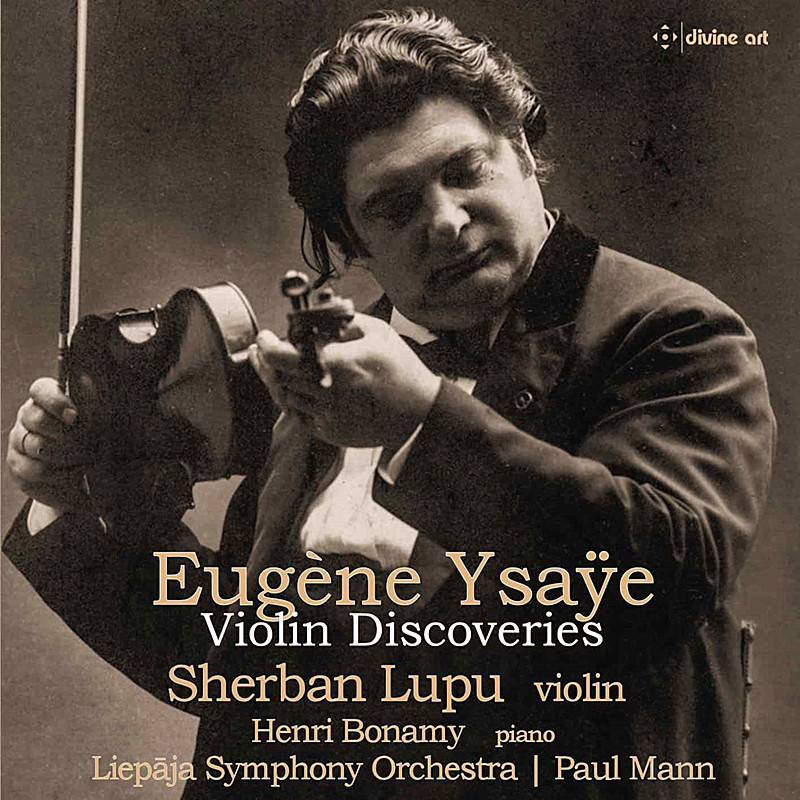 |
|
| |
尤金·伊萨依小提琴珍品展 舍尔班·卢普 小提琴
希里姆·博纳米 钢琴 利帕贾交响乐团 | 保罗·曼恩 |
|
|
|
| |
Bach played the organ to the
King of Prussia |
|
|
|
| |
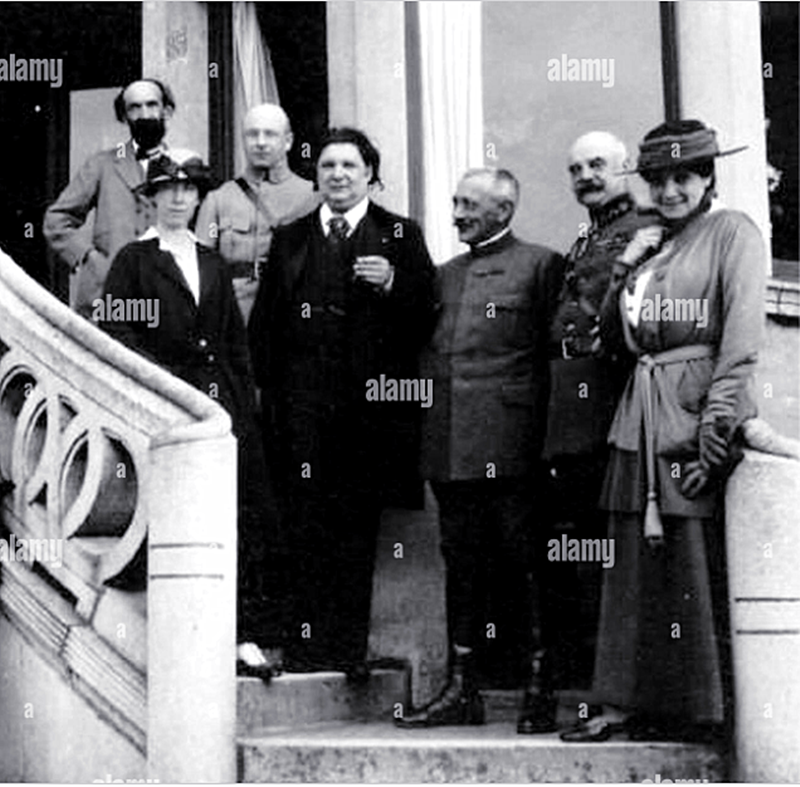 |
|
| |
伊莉莎白·巴伐利亚王后 尤金·伊萨依 基拉·克罗伊扎
1916 年 |
|
|
|
| |
Elisabeth of Bavaria Eugène
Ysaÿe Claire Croiza 1916. |
|
|
|
| |
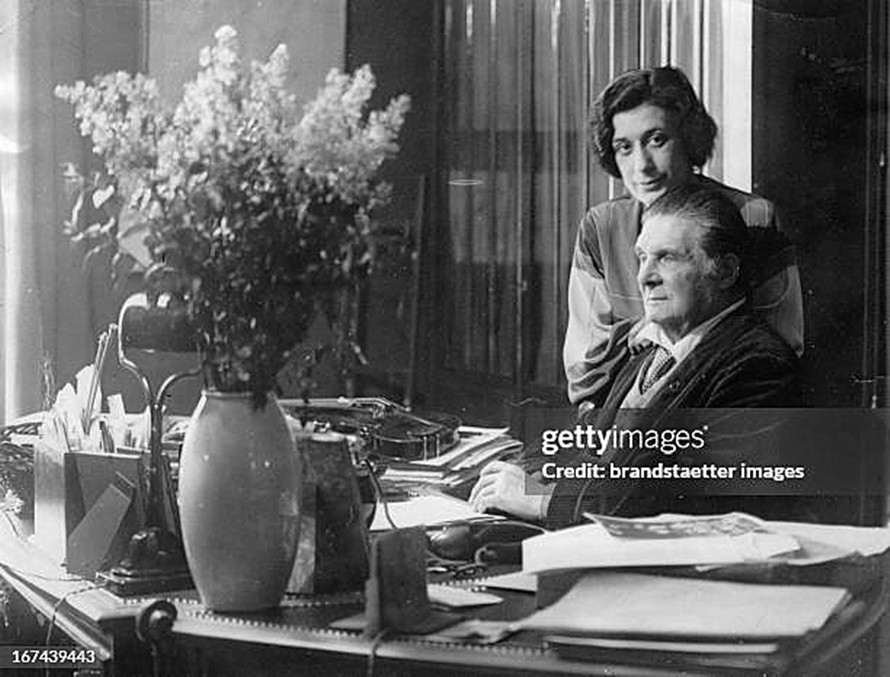 |
|
| |
埃贡·伊萨耶(1858 -
1931),比利时小提琴家,与他的第二任妻子珍妮特以及他们的家人于 1923 年左右在纽约相聚。 |
|
|
|
| |
EUGENE YSAYE
(1858-1931) Belgian violinist with his second wife Jeanette and
their family in New York about 1923. |
|
|
|
| |
 |
|
| |
拉乌尔·普诺与尤金·伊萨依——私人音乐会。
Raoul Pugno & Eugène Ysaÿe - Récital privé.
|
|
|
|
| |
Pages from Score of
the 'St. Matthew Passion' |
|
|
|
| |
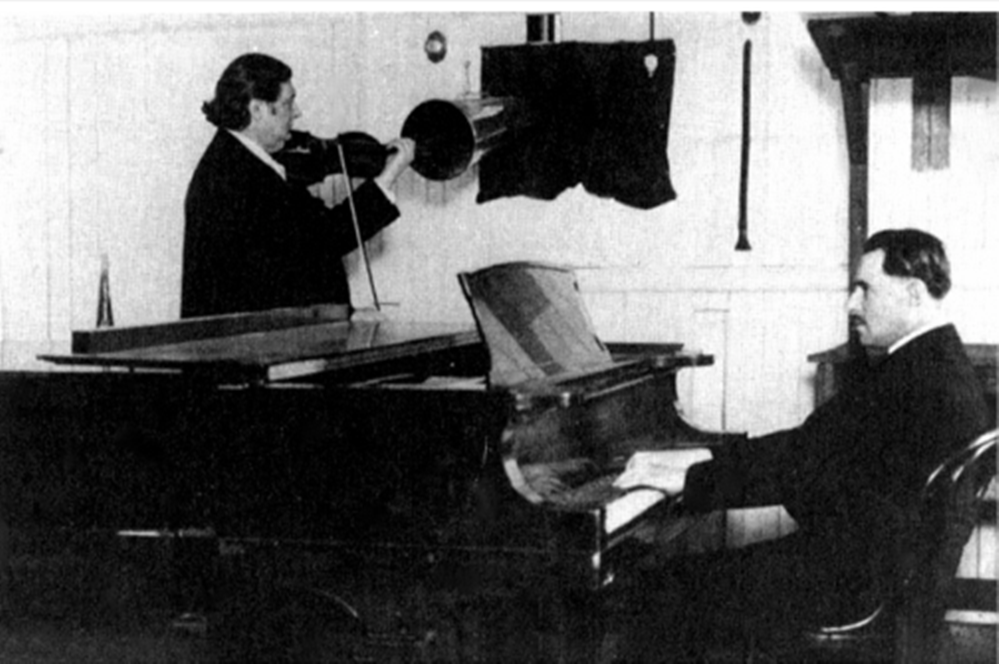 |
|
| |
伊萨耶与卡米尔·德雷克斯于 1912
年在哥伦比亚录音室的合影。他几乎肯定使用了他那架 1740 年的瓜尔尼乐器来进行这些录制 |
|
|
|
| |
: Ysaÿe with Camille
Decreus in the Columbia studios in 1912. He almost certainly
used his 1740 Guarneri for these recordings |
|
|
|
| |
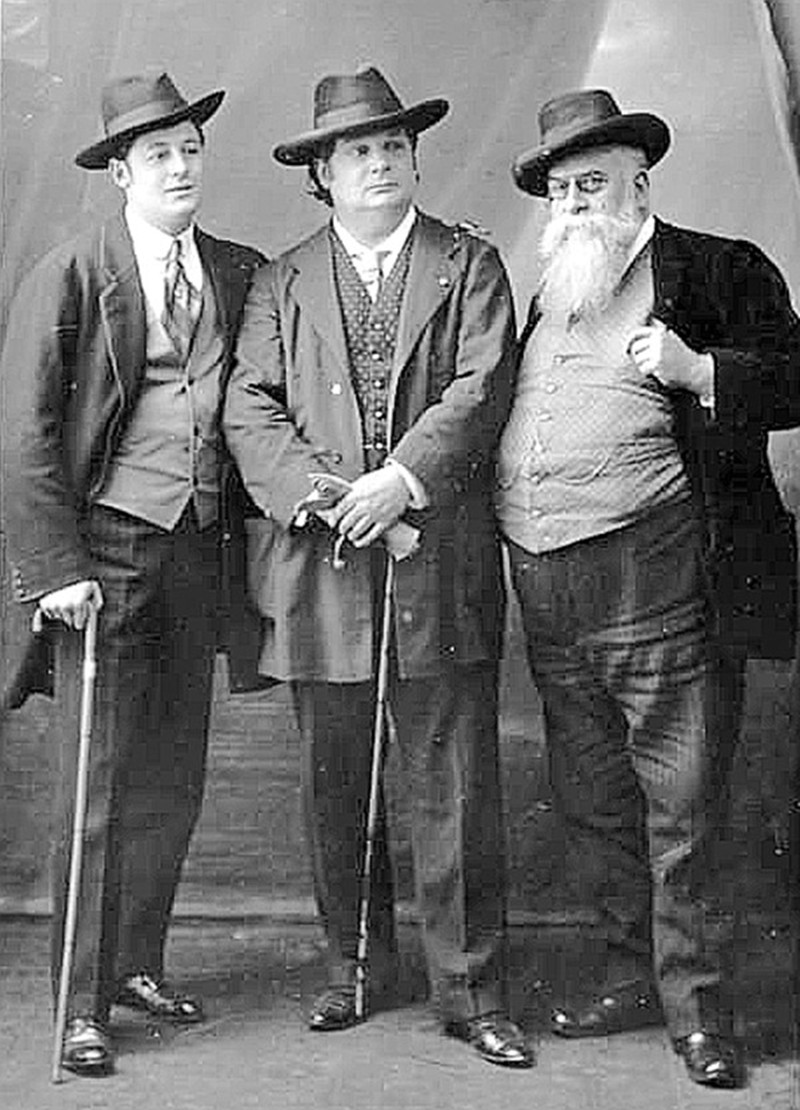 |
|
| |
泰奥·伊萨耶、尤金·伊萨依、拉乌尔·普诺 |
|
|
|
| |
Théo Ysaÿe, Eugène
Ysaÿe, Raoul Pugno |
|
|
|
| |
|
|
|
|
| |
尤金·伊萨依的创新弓法 |
|
|
|
| |
亨利•罗斯认为,在伊於依的演奏中,体现着最淋滴尽致的浪漫主义精神。他是一位发乎至情的艺术家,兼备娴熟的技巧和优美的音色,更有热情洋滥的激情。在演奏中,他喜欢在不损害原作
凤骨的基础上随兴所至而又恰到好处地改动一个音,变换一下节奏以增添作品的新鲜感。比方说他每次演奏同一首乐曲中的同一个抒情段落时,总是采用不同的指法和弓法,极少重复。这种在
19世纪曾风靡一时的浪漫主义遗风神韵在以后日渐崇尚法则、从众的年代里已变得寥若晨星,形同古迹。在伊萨依的演奏中很有些后人无法效仿,甚至在今天看来是令人匪夷所思的独特手法,如借助上半弓上推时所产生的爆发力来增加音色的亮度;在下弓时采用回弓(指一个长音拉至弓尖时突然松弛对弓的压力并迅速地把弓推回到中部继续拉第二个下弓的弓法)使音保持令人难以觉察丝毫的连贯性;还有多用空弦以拓展音响色彩的丰富性和用弓子靠近指板或在指板上轻轻擦弦以获取空灵悠扬的长笛效果等等。伊萨依的揉指是他个性的直接延伸,它得自于维尼亚大斯基的真传,速度和色彩细腻敏感、富于变化。当他的同时代人都尽情地在抒情乐句用上甜膩而夸张的揉指时,伊萨依却根本不用揉指,他主张应依靠弓本身的表现力来达到艺术效果。卡尔•弗莱什盛赞他的音色“宏亮而高贵”。同样,伊萨依的演奏中也并不因为频繁地使用滑音和换把而令人感到有粗俗的意味,相反,正是由于这些与众不同的艺术手法,使得他的演奏个性鲜明,充满魅力。
在伊萨依艺术生涯全盛时期的二十多年中,他演奏了小提琴文献宝库中的大量作品。总的说来,在演释德奥古典作品方面较之约阿希
姆不免稍逊一筹,而在表现浪漫派作品,尤其是法国提琴作品时他确乎称得上是独领风骚的。伊萨依的记忆力极其惊人,他演奏时从不用乐谱。当学生演奏时他会在旁边用自己的小提琴即兴拉出钢琴伴奏部分的旋律,而且和声丝毫不差。无论是多么艰深的乐曲,只要学生遇到困难,他就会亲自示范给学生听,其熟稳程度简直使人相信他当下就一直在练习这首乐曲。从1898
年起,为了使自己有更多的演出机会,伊萨依放弃了音乐学院的教职。 |
|
|
|
| |
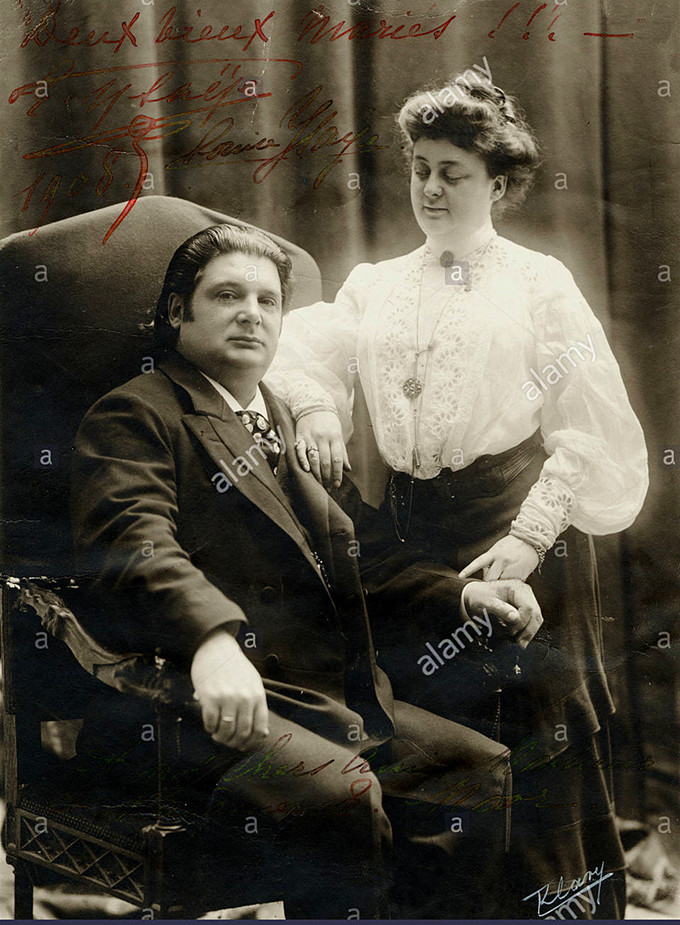 |
|
| |
尤金·伊萨依和他妻子。 比利时小提琴家,指挥家和作曲家。 克拉里工作室的照片。
签字日期是1908年。 1858-1931. |
|
|
|
| |
Above Eugène Ysaye
with his wife. Belgian violinist, conductor and composer. Photo by Klary
studio. Date of signature is 1908. 1858-1931. |
|
|
|
| |
Eugene
Isayev's innovation in violin bowing techniques |
|
|
|
| |
Henry Ross
believes that in Iouri's performance, the most exquisite and
passionate romantic spirit is embodied. He is an artist who
expresses his emotions freely, possessing both proficient skills
and beautiful tone, as well as abundant passionate energy.
During the performance, he likes to modify a note or change the
rhythm freely without damaging the original melody, to add
freshness to the work. For example, every time he performs the
same lyrical section of the same piece, he always uses different
fingerings and bowing techniques, rarely repeating. This
romanticist legacy that was popular in the 19th century has
become scarce and like an ancient relic in the era that
increasingly values rules and conformity. In Iosy's performance,
there are some unique techniques that later generations cannot
imitate, and even seem bizarre today. For instance, he uses the
explosive force generated by pushing upwards with the upper bow
to increase the brightness of the tone; when using the lower
bow, he adopts the reverse bowing (when pulling a long note to
the tip of the bow and suddenly relaxing the pressure on the bow
and quickly pushing the bow back to the middle to continue the
second lower bow) to maintain imperceptible continuity of the
sound; and he often uses open strings to expand the richness of
the sound color and uses the bow to approach the fingerboard or
gently rub the strings on the fingerboard to achieve the
ethereal and melodious effect of the flute, etc. Iosy's plucking
fingers are a direct extension of his personality, which comes
from the genuine transmission of Vigna Daski. The speed and
color are delicate, sensitive, and full of variation. When his
contemporaries were using sweet and exaggerated plucking fingers
in the lyrical phrases, Iosy did not use plucking fingers at
all. He advocated relying on the expressiveness of the bow to
achieve artistic effects. Karl Fliesch praised his tone as "loud
and noble". Similarly, in Iosy's performance, frequent use of
glissando and changing the position of the bow does not make it
seem vulgar. On the contrary, it is precisely because of these
distinctive artistic techniques that his performance is
distinctively individual and full of charm. |
|
|
|
| |
During the
two decades when Isaïe was at the peak of his artistic career,
he performed a large number of works from the treasure trove of
violin literature. Generally speaking, in interpreting the
classical works of Germany and Austria, he was somewhat inferior
to Joachim. However, when it came to expressing romantic works,
especially French violin pieces, he was truly the undisputed
leader. Isaïe had an astonishing memory. He never used the score
when performing. When a student was playing, he would play the
melody of the piano accompaniment part on his own violin right
beside them, and the harmony was exactly the same. No matter how
difficult the piece was, whenever a student encountered
difficulties, he would personally demonstrate it to the student,
and his proficiency was so great that it made people believe
that he was actually practicing this piece at that moment.
Starting from 1898, in order to have more performance
opportunities, Isaïe gave up his teaching position at the music
academy. |
|
|
|
| |
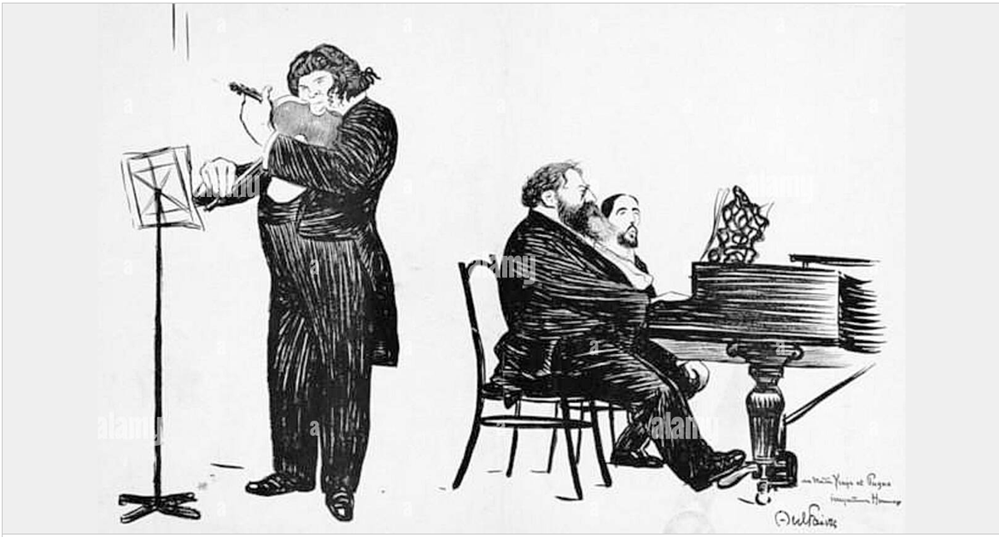 |
|
| |
尤金·伊萨依和钢琴家的漫画 |
|
|
|
| |
Today in
the history of music
On this day in the history of music, September 28, 1886, Eugene
Ysaye received A surprise gift at his wedding, the Violin Sonata
in A Major composed by his compatriot Sesel Frank. Eugene Ysaye
(July 16, 1858 - May 12, 1931) was born into a poor family that
had been engaged in the nail-making industry since the 16th
century. Isai's father, disregarding the family tradition,
became a seaman. He was an outstanding amateur violinist and
also served as the music director of the local church. Isai
began to learn the violin from his father when he was four years
old. However, he was not a child prodigy. As a child who was
both passionate and willful, he often played noisily with his
friends and was unwilling to practice for a long time as his
parents required. In 1865, when he was only seven years old, he
entered the Liege Conservatory of Music. A year later, he ranked
second, but was expelled from the school in 1869. We can't be
sure of the specific reason for his dismissal. It seems that it
was caused by the inconsistency between his father's teaching
methods and those of the music academy. The conservatory
admitted that he was "talented", but complained that he "didn't
practice the piano". After that, Isai participated in local
music events together with his father. He also tried to become
an armored soldier, but was soon dismissed because he had no
interest in military service at all.
Today's
video: 1. Jacques Thibaud and Alfred Cortot - Frank's "Sonata
for Violin in A Major"; 2. Ashkenazy and Perlman perform Frank's
"Sonata for Violin and Piano in A Major". |
|
|
|
| |
 |
|
|
|
| |
尤金·伊萨依小提琴珍品展 舍尔班·卢普 小提琴
希里姆·博纳米 钢琴 利帕贾交响乐团 | 保罗·曼恩 |
|
|
|
| |
Bach played the organ to the
King of Prussia |
|
|
|
| |
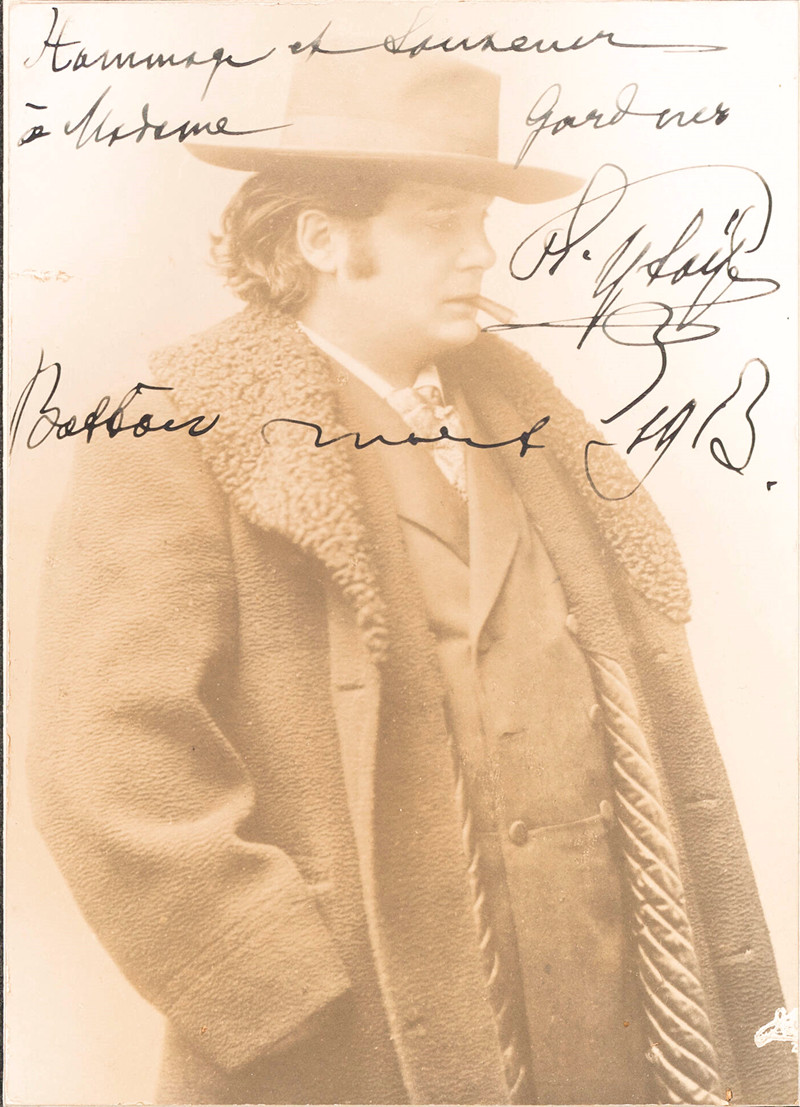 |
|
|
|
| |
尤金·伊萨依签名图片 |
|
|
|
| |
伊丽莎白皇后国际音乐比赛的来源 |
|
|
|
| |
1930
年是比利时独立 100 周年的日子。11月13日,右小腿己被截肢的伊萨依被拾上舞台,在庆祝大会上指挥了由
500 人组成的大乐队。次年5 月
12日,这位被比利时奉为国宝的伟大小提琴家与世长辞,他的心脏装在贵重的小匣子里被运到了列日,长眠于他故乡的土地中。比利时政府为了纪念他,手1937年起在布鲁塞尔举办了以他的名字命名的“伊萨依国际小提琴比赛”,这项比赛在50年代被改名为人们更熟悉的“伊莉莎白皇后国际音乐比赛”。 |
|
|
|
| |
The origin of the Elizabeth Queen International
Music Competition
1930 marked the 100th anniversary of Belgium's
independence. On November 13th, Issay, whose right
leg had been amputated, was carried onto the stage
and led the 500-member large orchestra at the
celebration ceremony. On May 12th of the following
year, this great violinist, revered as a national
treasure by Belgium, passed away. His heart was
placed in a precious box and transported to Liège,
where he was laid to rest in the land of his
hometown. The Belgian government, in order to
commemorate him, started holding the "Issay
International Violin Competition" in Brussels under
his name in 1937. This competition was renamed the
"Queen Elizabeth International Music Competition" by
the 1950s, which is the more familiar name to
people. |
|
|
|
| |
 |
|
|
|
| |
巴托洛梅奥·朱塞佩·瓜尔内里·“德尔·杰苏”(1740 年,克雷莫纳),《伊萨耶》
小提琴:40064
Bartolomeo Giuseppe Guarneri 'del Gesù', Cremona,
1740, the 'Ysaÿe' |
|
|
|
| |
|
|
|
|
| |
 |
|
|
|
| |
巴托洛梅奥·朱塞佩·瓜尔内里·“德尔·杰苏”(1740 年,克雷莫纳),《伊萨耶》
小提琴:40064 |
|
|
|
| |
Bartolomeo Giuseppe
Guarneri 'del Gesù', Cremona, 1740, the 'Ysaÿe' |
|
|
|
| |
 |
|
|
|
| |
巴托洛梅奥·朱塞佩·瓜尔内里·“德尔·杰苏”(1740 年,克雷莫纳),《伊萨耶》
小提琴:40064 |
|
|
|
| |
Bartolomeo Giuseppe
Guarneri 'del Gesù', Cremona, 1740, the 'Ysaÿe' |
|
|
|
| |
 |
|
| |
巴托洛梅奥·朱塞佩·瓜尔内里·“德尔·杰苏”(1740
年,克雷莫纳),《伊萨耶》
小提琴:40064 |
|
|
|
| |
Bartolomeo Giuseppe Guarneri
'del Gesù', Cremona, 1740, the 'Ysaÿe' |
|
|
|
| |
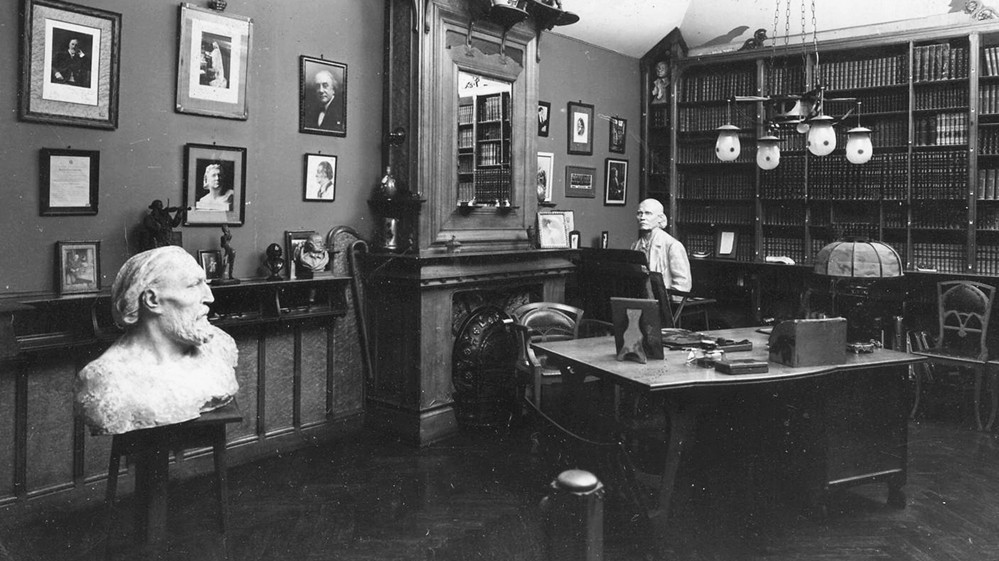 |
|
| |
尤金·伊萨依工作室 |
|
|
|
| |
尽管列日音乐家欧根·耶萨耶(1858 -
1931)是一位享誉国际的小提琴家、作曲家和指挥家,但公众却忽略了他本人要求由卢森堡列日同代人古斯塔夫·塞鲁里耶-博瓦(1858 -
1910)所创建的这个工作室。古斯塔夫·塞鲁里耶-博瓦是耶萨耶先生同时代的一位杰出人物。这个非凡人物和那个时代的独特见证,由耶萨耶先生的继承人通过遗赠被添加到了列日市的收藏品中。在福格尔街的音乐学院内,该工作室被忠实地重建。1977
年,它被迁至位于乌尔苏琳小巷的原邮局大楼的二楼,那里现在是建筑博物馆,最终被安置在格朗·库蒂斯博物馆的永久性展览空间内。
许多人并不知道“比利时伊丽莎白女王国际音乐比赛”,也就是通常所说的“伊丽莎白女王比赛”,这个比赛的构想是出自尤金·伊萨依之手,灵感来源于他的朋友伊丽莎白女王。该比赛旨在帮助
30 岁以下的年轻演奏者崭露头角。因此,“伊萨依比赛”于 1937 年诞生。由于战争的干扰,比赛在 1951 年以现在的名称重新举行。 |
|
|
|
| |
The
Eugène Ysaye Studio
Although the Liège musician Eugène Ysaye (1858–1931) is an
internationally-renowned violinist, composer and conductor, the public
overlooks the studio created at his request by Gustave Serrurier-Bovy
(1858–1910), one of his contemporaries from Liège. This unique testimony
of an exceptional man and an era has been added to the collections of
the City of Liège by bequest Eugène Ysaye's heirs. Faithfully
reconstituted in the premises of the conservatory on rue Forger, the
Studio was transferred in 1977 to the second floor of the former Post
Office in the Ursulines cul-de-sac, which is now the Museum of
Architecture, before finally being housed in permanent spaces at the
Grand Curtius museum.
Many people are
unaware that the "Queen Elisabeth International Musical Competition of
Belgium", commonly known as the "Queen Elisabeth Competition", is an
idea that Eugène Ysaye got from his friend, Queen Elisabeth. This
contest helps young performers under the age of 30 to get their names
out there. Thus the “Ysaye Competition” was born in 1937. Interrupted by
the war, it resumed in 1951 under the name by which it is known today. |
|
|
|
| |
|
|
| |
阿什肯纳齐/帕尔曼·弗兰克-A大调小提琴与钢琴奏鸣曲 |
|
|
|
| |
Ashkenazy·Perlman:Franck-Sonata A major
Violin·Piano |
|
|
|
| |
阿什肯纳齐与佩尔曼:塞萨尔·弗兰克——A大调小提琴与钢琴奏鸣曲
3月14日
2022年
阿什肯纳齐与佩尔曼:塞萨尔·弗兰克——A大调小提琴与钢琴奏鸣曲
伊扎克·帕尔曼 - 小提琴
弗拉基米尔·阿什肯纳齐 - 钢琴
英国室内乐团 |
|
|
|
| |
Ashkenazy and Perlman: César Franck - Sonata in A
major for Violin and Piano 3月14日 2022年 Ashkenazy and Perlman:
César Franck - Sonata in A major for Violin and Piano Itzhak
Perlman - violin Vladimir Ashkenazy - piano English Chamber
Orchestra |
|
|
|
| |
|
|
|
|
| |
未得原作者编者授权严禁转载www.mt77.com任何内容 |
|
|
|


